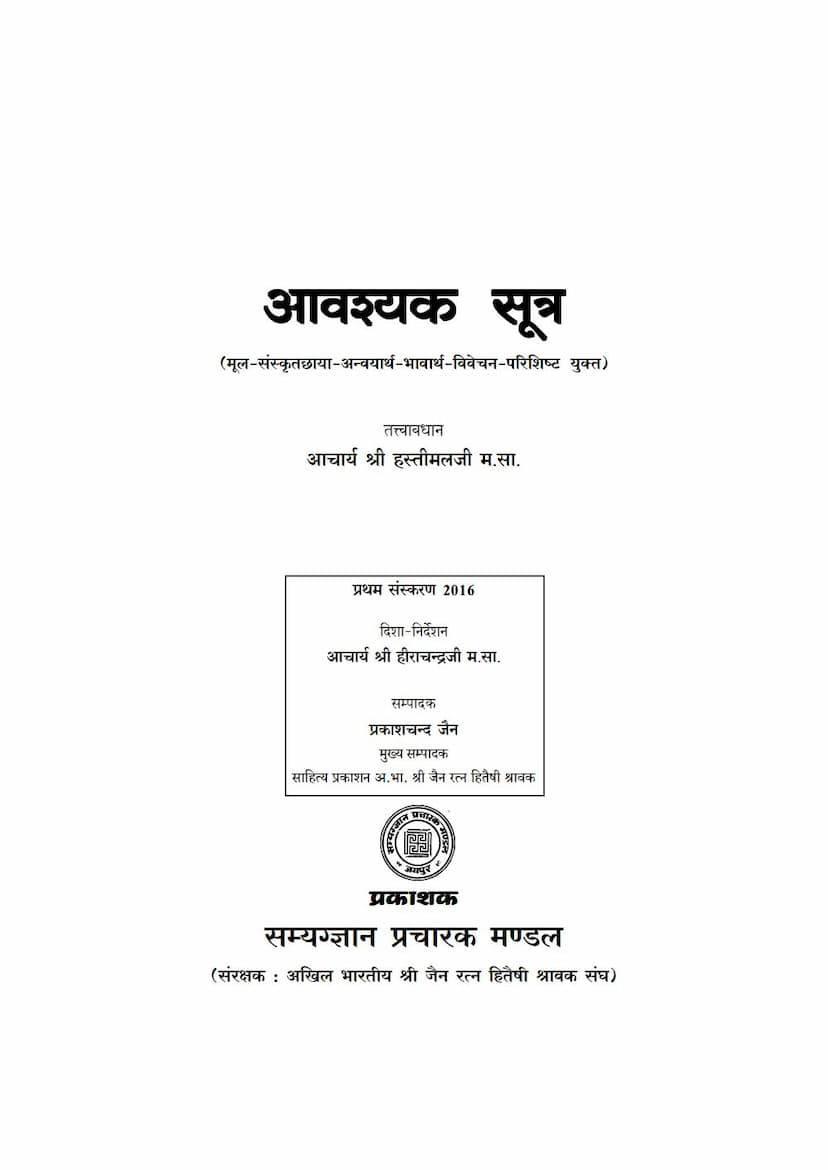Aavashyak Sutra
Added to library: September 1, 2025

Summary
The "Aavashyak Sutra" (आवश्यक सूत्र), authored by Acharya Hastimalji M.S. and published by Samyaggyan Pracharak Mandal, is a foundational Jain text that details essential daily practices for spiritual aspirants. The book, first published in 2016, under the guidance of Acharya Hirachandji M.S., provides the original Sanskrit text, its translation, meaning, commentary, and supplementary appendices.
The Aavashyak Sutra, also known as "Pratikraman," is considered the 32nd and final Anga (part) of the 32 Agamas (canonical scriptures). Its core purpose is to guide seekers in purifying themselves from daily faults and mistakes through self-reflection, confession, and atonement. The text emphasizes that "Aavashyak" means "that which must be done," highlighting its indispensable nature in the Jain path.
The book elaborates on the six essential duties (Aavashyakas) that form the backbone of Jain spiritual practice:
-
Samayik (सामायिक): This is the foremost duty, focusing on achieving equanimity and dwelling in one's true soul-self. It involves abstaining from sinful activities (Savadyog Virati) and cultivating a state of mental stillness and concentration. The text stresses that true Samayik is attained by those whose souls are absorbed in restraint, discipline, and penance, and who maintain an equal disposition towards all living beings.
-
Chaturvimsatistav (चतुर्विंशति स्तव): This duty involves praising the virtues of the 24 Tirthankaras. This praise, or Uttikirtan, is seen as a way to purify one's vision (Darshan Vishuddhi), gain spiritual insight (Bodhilabh), and shed accumulated karma (Karmakshay). Devotion to the Tirthankaras is believed to bestow strength and remove impurities.
-
Vandana (वंदना): This practice involves venerating one's spiritual preceptors (gurus). It fosters humility, reduces ego, and helps in absorbing the virtues of the gurus. The text emphasizes the importance of showing respect and reverence to those who guide the spiritual path.
-
Pratikraman (प्रतिक्रमण): This is the core of the Aavashyak Sutra, focusing on self-introspection and atonement for past faults. It involves confessing sins (Ninda and Garha), repenting, and resolving not to repeat them. The text details various types of Pratikraman, including those performed daily, fortnightly, and annually, to purify oneself from accumulated karma. It also outlines six types of Pratikraman: Uchchar Pratikraman (after defecation), Prasravan Pratikraman (after urination), Itvarik Pratikraman (daily), Yavatkathit Pratikraman (during end-of-life vows), Yatkinchit Mithya (for minor faults), and Swapnantik Pratikraman (after bad dreams).
-
Kayotsarga (कायोत्सर्ग): This practice involves detaching oneself from the body and its sensations, focusing on the purity of the soul. It is considered a form of "Vran Chikitsa" (wound healing) for the spiritual body, where faults committed are seen as wounds that need healing through penance and meditation. The aim is to achieve a state of detachment from the body and mind.
-
Pratyakhyan (प्रत्याख्यान): This involves making vows or resolutions to abstain from certain actions or desires, either for a specific period or for life. It is about controlling desires (Ichcha Nirodh) and cultivating virtues (Gundharana). The text lists ten types of Pratyakhyan, such as Anagat (postponed), Atikrant (past), and various forms of timed renunciations like Navkarsi, Pausudhi, and Ekasan.
The "Aavashyak Sutra" also delves into the historical context of these practices, the different interpretations and traditions regarding their performance (especially for lay followers), and the philosophical underpinnings of each essential duty. It highlights the fourfold classification of "Aavashyak" as Nama (name), Sthapana (establishment), Dravya (material), and Bhava (mental/spiritual state). The ultimate goal of all these practices is to achieve purification, spiritual growth, and ultimately, liberation (Moksha).
The book further includes detailed discussions on the proper pronunciation of scriptures, the concept of "Ashvayik" (times when scripture reading is prohibited), and the significance of the Namokar Mantra. It also provides extensive explanations of the six Aavashyakas, their benefits, and the underlying principles, offering insights into the meticulousness of Jain spiritual discipline. The appendices offer specific methodologies for monks and nuns (Shraman) and lay followers (Shravak), along with question-and-answer sections and supplementary texts.
In essence, the "Aavashyak Sutra" serves as a comprehensive guide to the essential spiritual disciplines that are considered vital for every Jain follower, regardless of their stage of spiritual pursuit, aiming for self-purification and the ultimate realization of the soul's true nature.